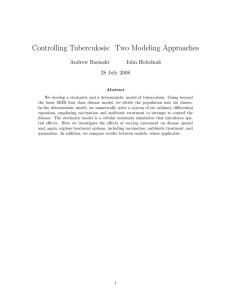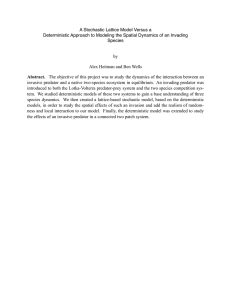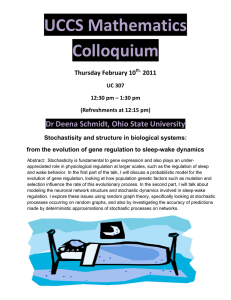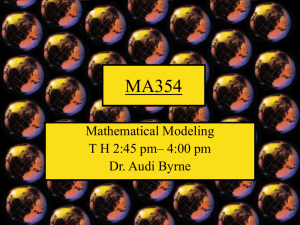Document 10843893
advertisement
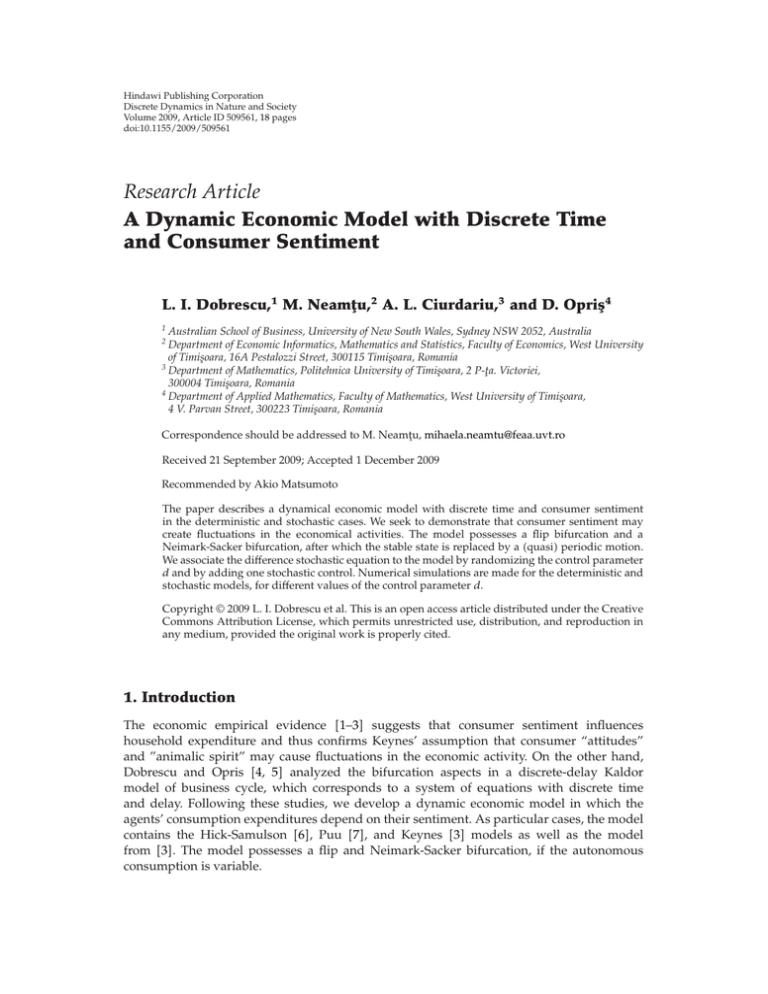
Hindawi Publishing Corporation
Discrete Dynamics in Nature and Society
Volume 2009, Article ID 509561, 18 pages
doi:10.1155/2009/509561
Research Article
A Dynamic Economic Model with Discrete Time
and Consumer Sentiment
L. I. Dobrescu,1 M. Neamţu,2 A. L. Ciurdariu,3 and D. Opriş4
1
Australian School of Business, University of New South Wales, Sydney NSW 2052, Australia
Department of Economic Informatics, Mathematics and Statistics, Faculty of Economics, West University
of Timişoara, 16A Pestalozzi Street, 300115 Timişoara, Romania
3
Department of Mathematics, Politehnica University of Timişoara, 2 P-ţa. Victoriei,
300004 Timişoara, Romania
4
Department of Applied Mathematics, Faculty of Mathematics, West University of Timişoara,
4 V. Parvan Street, 300223 Timişoara, Romania
2
Correspondence should be addressed to M. Neamţu, mihaela.neamtu@feaa.uvt.ro
Received 21 September 2009; Accepted 1 December 2009
Recommended by Akio Matsumoto
The paper describes a dynamical economic model with discrete time and consumer sentiment
in the deterministic and stochastic cases. We seek to demonstrate that consumer sentiment may
create fluctuations in the economical activities. The model possesses a flip bifurcation and a
Neimark-Sacker bifurcation, after which the stable state is replaced by a quasi periodic motion.
We associate the difference stochastic equation to the model by randomizing the control parameter
d and by adding one stochastic control. Numerical simulations are made for the deterministic and
stochastic models, for different values of the control parameter d.
Copyright q 2009 L. I. Dobrescu et al. This is an open access article distributed under the Creative
Commons Attribution License, which permits unrestricted use, distribution, and reproduction in
any medium, provided the original work is properly cited.
1. Introduction
The economic empirical evidence 1–3 suggests that consumer sentiment influences
household expenditure and thus confirms Keynes’ assumption that consumer “attitudes”
and ”animalic spirit” may cause fluctuations in the economic activity. On the other hand,
Dobrescu and Opris 4, 5 analyzed the bifurcation aspects in a discrete-delay Kaldor
model of business cycle, which corresponds to a system of equations with discrete time
and delay. Following these studies, we develop a dynamic economic model in which the
agents’ consumption expenditures depend on their sentiment. As particular cases, the model
contains the Hick-Samulson 6, Puu 7, and Keynes 3 models as well as the model
from 3. The model possesses a flip and Neimark-Sacker bifurcation, if the autonomous
consumption is variable.
2
Discrete Dynamics in Nature and Society
The implications of the stochastic noise on the economic process are studied. The
stochastic difference equation with noise terms is scaled appropriately to account for intrinsic
as well as extrinsic fluctuations. Under the influence of noise the difference equation behaves
qualitatively different compared to its deterministic counterpart.
The paper is organized as follows. In Section 2, we describe the dynamic model
with discrete time using investment, consumption, sentiment, and saving functions. For
different values of the model parameters we obtain well-known dynamic models HickSamuelson, Keynes, Pu. In Section 3, we analyze the behavior of the dynamic system in
the fixed point’s neighborhood for the associated map. We establish asymptotic stability
conditions for the flip and Neimark-Sacker bifurcations. In both the cases of flip and
Neimark-Sacker bifurcations, the normal forms are described in Section 4. Using the QR
method, the algorithm for determining the Lyapunov exponents is presented in Section 5.
In Section 6, a stochastic model with multiplicative noise is associated to the deterministic
model. These equations are obtained by randomizing one parameter of the deterministic
equation or by adding one stochastic control. Finally, the numerical simulations are done
for the deterministic and stochastic equations. The obtained simulations show major changes
between the deterministic and stochastic cases. The analysis of the present model proves
its complexity and allows the description of the different scenarios which depend on
autonomous consumption.
2. The Mathematical Model with Discrete Time and
Consumer Sentiment
Let yt, t ∈ N be the income at time step t and let
1 the investment function It, t ∈ N, be given by
3
It v yt − 1 − yt − 2 − w yt − 1 − yt − 2 , v > 0, w ≥ 0;
2.1
2 the consumption function Ct, t ∈ N, be given by
Ct a yt − 1b cSt − 1,
a ≥ 0, b > 0, c ≥ 0,
2.2
where St, t ∈ N, is the sentiment function given by
St 1
,
1 ε exp yt − 1 − yt
ε ∈ 0, 1;
2.3
3 the saving function Et, t ∈ N, be given by
Et d yt − 2 − yt − 1 mSt − 1,
d ≥ 0, m ≥ 0.
2.4
The mathematical model is described by the relation:
yt It Ct Et.
2.5
Discrete Dynamics in Nature and Society
3
From 2.1, 2.2, 2.3, 2.4, and 2.5 the mathematical model with discrete time and
consumer sentiment is given by
yt a dyt − 2 b − dyt − 1 v yt − 1 − yt − 2
−wyt − 1 − yt − 23 cyt − 1 m
,
1 ε exp yt − 2 − yt − 1
t ∈ N.
2.6
The parameters from 2.6 have the following economic interpretations. The parameter
a represents the autonomous expenditures. The parameter d is the control, d ∈ 0, 1, and it
characterizes a part of the difference between the incomes obtained at two time steps t − 2 and
t − 1, which is used for consumption or saving in the time step t. The parameter c, c ∈ 0, 1,
is the trend towards consumption. The parameter m, m ∈ 0, 1, is the trend towards the
saving. The parameter b, b ∈ 0, 1, represents the consumer’s reaction against the increase
or decrease of his income. When the income strongly decreases, the consumer becomes
pessimistic and consumes 0 < b < 1 of his income. When the income strongly increases, the
consumer becomes optimistic and consumes b < b c < 1 of his income. Note that Souleles
8 finds, in fact, that higher consumer confidence is correlated with less saving and increases
in relation to expected future resources. The parameters v and w, v > 0, w ≥ 0 describe the
investment function. If w 0, the investment function is linear. The parameter ε, ε ∈ 0, 1,
describes a family of the sentiment functions.
For different values of the model parameters, we obtain the following classical models:
1 for a 0, b 1 − s, d 0, m 0, ε 0, s ∈ 0, 1 from 2.6 we obtain the HickSamuelson model 6:
yt 1 v − syt − 1 − vyt − 2,
2.7
v > 0, s ∈ 0, 1;
2 for v w 0, ε 0, m 0, 2.6 gives us the Keynes model 6:
yt d yt − 2 − yt − 1 a byt − 1;
2.8
3 for v w 0, ε 1, 2.6 leads to the model from 4:
yt d yt − 2 − yt − 1 a byt − 1 cyt − 1 m
,
1 exp yt − 2 − yt − 1
t ∈ N;
2.9
4 for a 0, b s − 1, d 0, m 0, w 1 v, ε 0, from 2.6 we get the Puu model
7:
yt v yt − 1 − yt − 2 − 1 vyt − 1 − yt − 23 − 1 − syt − 1.
2.10
4
Discrete Dynamics in Nature and Society
3. The Dynamic Behavior of the Model 2.6
Using the method from Kusnetsov 4, 6, 9, we will analyze the system 2.6, considering the
parameter a as bifurcation parameter. The associated map of 2.6 is F : R2 → R2 given by
F
y
z
⎞
cy m
⎟
⎜a b − d vy d − vz − wy − z ⎝
1 ε exp z − y ⎠.
y
⎛
3
3.1
Using the methods from 5, 6, 9, the map 3.1 has the following properties.
Proposition 3.1. i If 1 ε1 − b − c > 0, then, for the map 3.1, the fixed point with the positive
components is E0 y0 , z0 , where
y0 p1 a p2 ,
p1 1 ε
,
1 ε1 − b − c
z0 y0 ,
p2 3.2
m
.
1 ε1 − b − c
3.3
ii The Jacobi matrix of the map F in E0 is given by
A
a11 a12
1
0
3.4
,
where: a11 p3 a − p4 p5 , a12 −p3 a p4 ,
p3 εc
1 ε
2
p1 ,
p4 d − v −
εm
2
1 ε
−
εc
1 ε
2
p2 ,
p5 b c
.
1 ε
3.5
iii The characteristic equation of matrix A is given by
3.6
λ2 − a11 λ − a12 0.
iv If the model parameters d, v, ε, b, c, m satisfy the following inequality:
1 d − v1 ε1 ε1 − b − c − mε1 − b > 0,
3.7
then, for 3.6, the roots have the modulus less than 1, if and only if a ∈ a1 , a2 , where
a1 2p4 − p5 − 1
,
2p3
a2 1 p4
.
p3
3.8
v If the model parameters d, v, ε, b, c, m satisfy the inequality 3.7 and a a1 , then, one
of equation 3.6’s roots is −1, while the other one has the modulus less than 1.
Discrete Dynamics in Nature and Society
5
vi If the model parameters d, v, ε, b, c, m satisfy the inequality 3.7 and a a2 , then, 3.6
has the roots μ1 a μa, μ2 a μa, where |μa| 1.
Using 7 and Proposition 3.1, with respect to parameter a, the asymptotic stability
conditions of the fixed point, the conditions for the existence of the flip and Neimark-Sacker
bifurcations are presented in the following.
Proposition 3.2. i If 1 ε1 − b − c > 0, the inequality 3.7 holds and 2p4 − p5 − 1 > 0, then for
a ∈ a1 , a2 the fixed point E0 is asymptotically stable. If 1 ε1 − b − c > 0, the inequality 3.7
holds, and 2p4 − p5 − 1 < 0, then for a ∈ 0, a2 the fixed point E0 is asymptotically stable.
ii If 1 ε1 − b − c > 0, the inequality 3.7 holds, and 2p4 − p5 − 1 > 0, then a a1 is a
flip bifurcation and a a2 is a Neimark-Sacker bifurcation.
iii If 1 ε1 − b − c > 0, the inequality 3.7 holds and 2p4 − p5 − 1 < 0, then a a2 is a
Neimark-Sacker bifurcation.
4. The Normal Form for Flip and Neimark-Sacker Bifurcations
In this section, we describe the normal form in the neighborhood of the fixed point E0 , for the
cases a a1 and a a2 .
We consider the transformation:
u1 y − y0 ,
u2 z − z0 ,
4.1
where y0 , z0 are given by 3.2. With respect to 4.1, the map 3.1 is G : R2 → R2 , where
Gu1 , u2 g1 u1 , u2 −
g1 u1 , u2 g2 u1 , u2 4.2
,
cu1 r
r
b − d vu1 d − vu2 − wu1 − u2 3 ,
1ε
1 ε expu2 − u1 g2 u1 , u2 u1 ,
4.3
r cy0 m.
The map 4.2 has O0, 0 as fixed point.
We consider
a11 l02 ∂g1
0, 0,
∂u1
∂2 g1
∂u22
0, 0,
a12 l30 ∂g1
0, 0,
∂u2
∂3 g1
∂u31
0, 0,
l03 l20 l21 ∂3 g1
∂u31
∂2 g1
∂u21
0, 0,
∂3 g1
∂u21 ∂u2
0, 0.
0, 0,
l11 ∂2 g1
0, 0,
∂u1 ∂u2
l12 ∂3 g1
∂u1 ∂u22
0, 0,
4.4
6
Discrete Dynamics in Nature and Society
We develop the function Gu, u u1 , u2 T in the Taylor series until the third order
and obtain
1
1
Gu Au Bu, u Du, u, u O |u|4 ,
2
2
4.5
where A is given by 3.4 and
T
T
Bu, u B1 u, u, 0 ,
Du, u, u D1 u, u, u, 0 ,
T l20 l11
1
u,
B u, u u
l11 l02
l30 l21
l21 l12
1
T
D u, u, u u u1
u2
u.
l21 l12
l12 l03
4.6
4.7
For a a1 , given by 3.8 with the condition v from Proposition 3.1, we have the
following.
Proposition 4.1. i The eigenvector q ∈ R2 , given by Aq −q, has the components:
q1 1,
q2 −1.
4.8
ii The eigenvector h ∈ R2 , given by hT A −hT , has the components:
h1 1
,
1 a12
h2 −
a12
.
1 a12
4.9
The relation q, h 1 holds.
iii The normal form of the map 3.1 on the center manifold in O0, 0 is given by
1
η −→ −η νη3 O η4 ,
6
4.10
where ν 1/1 a12 l30 − 3l21 3l12 − l03 3/1 − a11 − a12 l20 − 2l11 l02 2 .
The proof results from straight calculus using the formula 2.6:
ν r, D q, q, q
−1
3B q, I − A B q, q
,
1 0
I
.
0 1
4.11
For a a2 , given by 3.8 with the condition vi from Proposition 3.1, one has the
following.
Discrete Dynamics in Nature and Society
7
Proposition 4.2. i The eigenvector q ∈ C2 , given by Aq μ1 q, where μ1 is the eigenvalue of the
matrix A, has the components:
q1 1,
q2 μ2 μ1 .
4.12
ii The eigenvector h ∈ C2 , given by hT A μ2 hT , where μ2 μ1 , has the components:
h1 1
,
1 μ21 a12
h2 μ1 a12
1 μ21 a12
.
4.13
The relation q, h 1 holds.
Using 4.6 and 4.8 one has
B1 q, q l20 2l11 μ2 l02 μ22 ,
B1 q, q l20 l11 μ1 μ2 l02 μ1 μ2 ,
B1 q, q l20 2l11 μ1 l02 μ21 .
4.14
We denoted by
g20 v1 B1 q, q ,
w20
g 11 v1 B1 q, q ,
g02 v1 B1 q, q ,
h120 1 − v1 − v1 g20 ,
h111 1 − v1 − v1 g11 ,
h102 1 − v1 − v1 g02 ,
4.15
h220 − v1 μ2 v1 μ1 B1 q, q ,
h211 − v1 μ2 v1 μ1 B1 q, q ,
h202 − v1 μ2 v1 μ1 B1 q, q ,
1
−1 h1
−1 h1
h11
20
02
−1
2
2
,
w11 I − A
,
w02 μ2 − A
, 4.16
μ1 I − A
h220
h211
h202
where I 1 0
01
, A is given by 3.4, and
r20 B1 q, w20 ,
r11 B1 q, w11 ,
D0 D1 q, q, q l30 μ1 2μ2 l21 μ2 2μ1 μ2 l12 μ1 μ22 l03 ,
4.17
g21 v2 r20 2r11 D0 .
Using the normal form for the Neimark-Sacker bifurcation of the dynamic systems
with discrete time 6 and 4.15, 4.16, and 4.17, we obtain the following.
8
Discrete Dynamics in Nature and Society
Proposition 4.3. i The solution of the system 2.6 in the neighborhood of the fixed point y0 , z0 ∈
Rn is given by
1 2
1 2
2
xt2 w11
xtxt w02
xt2 ,
yt y0 μ2 xt μ1 xt w20
2
2
1 1
1 1
1
xt2 w11
xtxt w02
xt2 ,
yt − 1 zt z0 xt xt w20
2
2
4.18
where xt ∈ C is the solution of the following equation:
1
1
1
xt 1 μ1 xt g20 xt2 g11 xtxt g02 xt2 g21 xt2 xt.
2
2
2
4.19
ii A complex variable transformation exists so that 4.18 becomes
ωt 1 μ1 ωt Lc ωt2 ωt O |ωt|4 ,
4.20
g20 g11 μ2 − 3 − 2μ1
|g11 |2
|g20 |2
g21
Lc 2
2
2
1 − μ1
2 μ1 − μ1 μ2 − 1
2 μ1 − μ2
4.21
where
is the Lyapunov coefficient.
iii If l0 Ree−iθ Lc < 0, where θ argμ1 , then in the neighborhood of the fixed point
y0 , z0 there is a stable limit cycle.
5. The Lyapunov Exponents
If a1 > 0, then for a ∈ 0, a1 or a ∈ a2 , 1 the system 2.6 has a complex behavior and
it can be established by computing the Lyapunov exponents. We will use the decomposed
Jacobi matrix of map 3.1 into a product of an orthogonal matrix Q and an uppertriangular
matrix R with positive diagonal elements called QR algorithm 6. The determination of the
Lyapunov exponents can be obtained by solving the following system:
3
yt 1 a b − d vyt d − vzt − w yt − zt cyt m
,
1 exp zt − yt
zt 1 yt,
cos xt
xt 1 arctan −
,
f11 cos xt − f12 sin xt
λt 1 λt ln f11 − tan xt 1 cos xt cos xt 1 − f12 sin xt cos xt 1 ,
μt 1 μt ln f11 − tan xt 1 1 sin xt cos xt 1 f12 cos xt cos xt 1 ,
5.1
Discrete Dynamics in Nature and Society
9
with
2
∂f1 yt, zt b − d v − 3w yt − zt
∂y
c ε c m cyt exp zt − yt
,
2
1 ε exp zt − yt
2 ε m cyt exp zt − yt
∂f1 yt, zt d − v 3w yt − zt − 2 .
∂z
1 ε exp zt − yt
f11 f12
5.2
The Lyapunov exponents are
λt
,
t→∞ t
L1 lim
μt
.
t→∞ t
5.3
L2 lim
If one of the two exponents is positive, the system has a chaotic behavior.
6. The Stochastic Difference Equation Associated to
Difference Equation 2.6
Let Ω, F, {Ft }t∈N , P be a filtered probability space with stochastic basis and the filtration
{Ft }t∈N . Let {ξt}t∈IN be a real valued independent random variable on Ω, F, {Ft }t∈N , P with Eξt 0 and Eξt2 < ∞.
The stochastic difference equation associated to the difference equation 2.6 is given
by
yt1 a dyt − 1 b − dyt v yt − yt − 1 − wyt − yt − 13
cyt m
g yt, yt − 1 ξt.
1 ε exp yt − 1 − yt
6.1
The function gyt, yt − 1 is the contribution of the fluctuations while it is under certain
circumstances it is given by
g yt α yt − y0 ,
α≥0
6.2
or
g yt − 1, yt α yt − 1 − yt ,
α ≥ 0.
6.3
10
Discrete Dynamics in Nature and Society
550
540
530
520
510
500
490
480
470
460
100 200 300 400 500 600 700 800 900 1000
Figure 1: t, yt in the deterministic case for d 0.
From 6.1 and 6.2 the difference equation with multiplicative noise associated to the
difference equation 2.6 is given by
yt 1 a dzt b − dyt v yt − zt − wyt − zt3
cyt m
α yt − y0 ξt,
1 ε exp zt − yt
6.4
zt 1 yt,
where y0 is the fixed point of map 2.6.
Using 6.1 and 6.3 we have
yt 1 a dzt b − dyt v yt − zt − wyt − zt3
cyt m
α zt − yt ξt,
1 ε exp zt − yt
6.5
zt 1 yt.
By 2.6, randomizing parameter d equation 6.5 is obtained.
The analysis of the stochastic difference equations 6.4 and 6.5 can be done by using
the method from 10–12.
In what follows, we calculate an estimation of the upper forward 2 th moment
stability exponent given in 12 for the stochastic process yt, ztt∈N .
Let yt, ztt∈N be the process that satisfies 6.4. The system of stochastic difference
equations 6.4 has the form:
yt 1 yt f1 yt, zt f2 yt ξt,
zt 1 zt f3 yt, zt ,
6.6
Discrete Dynamics in Nature and Society
11
550
540
530
520
510
500
490
480
470
460
460 470 480 490 500 510 520 530 540 550
Figure 2: yt − 1, yt in the deterministic case for d 0.
650
600
550
500
450
100 200 300 400 500 600 700 800 900 1000
Figure 3: t, yt in the stochastic case for d 0.
where
f1 yt, zt b − d v − 1yt d − vzt − wyt − zt3
cyt m
,
1 ε exp zt − yt
f2 yt α yt − y0 ,
f3 yt, zt yt − zt.
6.7
12
Discrete Dynamics in Nature and Society
650
600
550
500
450
450
500
550
600
650
Figure 4: yt − 1, yt in the stochastic case for d 0.
540
530
520
510
500
490
480
470
100 200 300 400 500 600 700 800 900 1000
Figure 5: t, yt in the deterministic case for d 0.6.
The upper forward 2 th moment stability exponent of the stochastic process
yt, ztt∈N is defined by 12
1
λ2 lim sup ln E yt2 zt2 ,
t→∞ t
6.8
provided that this limit exists.
Using Theorem 2.2 12, for 6.5, with f1 , f2 , f3 given by 6.7 and w 0, we get the
following.
Discrete Dynamics in Nature and Society
13
540
530
520
510
500
490
480
470
460 470 480 490 500 510 520 530 540
Figure 6: yt − 1, yt in the deterministic case for d 0.6.
700
650
600
550
500
450
100 200 300 400 500 600 700 800 900 1000
Figure 7: t, yt in the stochastic case for d 0.6.
Proposition 6.1. Let yt, zt be the process which satisfies the stochastic difference equation 6.6
with w 0. Assume that, for all t ∈ N, yt, zt ∈ R2 ,
f1 yt, zt yt f3 yt, zt zt ≤ k1 yt2 zt2 ,
f1 yt, zt2 f3 yt, zt2 ≤ k2 yt2 zt2 ,
f2 yt, zt2 ≤ k3 yt2 zt2 ,
6.9
14
Discrete Dynamics in Nature and Society
700
650
600
550
500
450
450
500
550
600
650
700
Figure 8: yt − 1, yt in the stochastic case for d 0.6.
0.05
0
100 200 300 400 500 600 700 800 900 1000
−0.05
−0.1
−0.15
Figure 9: t, λt/t the Lyapunov exponent in the deterministic case for d 0.6.
where k1 , k2 , k3 are finite, deterministic, real numbers. Then
λ2 ≤ 2k1 k2 σ 2 k3 ,
6.10
with Eξt2 σ 2 .
If the parameters of the model are a 250, v 0.1, w 0, c 0.1, b 0.45, ε 1,
m 0.5, d 0.8, σ 0.5, and α 1, then for k1 15, k2 350, k3 1, the inequalities 6.9 are
satisfied and λ2 ≤ 380.25.
A similar result can be obtained for 6.5.
The qualitative analysis of the difference equations 6.4 and 6.5 is more difficult than
that in the deterministic case and it will be done in our next papers.
Discrete Dynamics in Nature and Society
15
540
530
520
510
500
490
480
470
100 200 300 400 500 600 700 800 900 1000
Figure 10: t, yt in the deterministic case for d 0.8.
540
530
520
510
500
490
480
470
460 470 480 490 500 510 520 530 540
Figure 11: yt − 1, yt in the deterministic case for d 0.8.
7. Numerical Simulation
The numerical simulation is done using a Maple 13 program. We consider different values for
the parameters which are used in the real economic processes. We use Box-Muller method for
the numerical simulation of 6.4.
For system 6.4 with α 1, a 250, v 0.1, w 0, c 0.1, b 0.45, ε 1, m 0.5
and the control parameter d 0 we obtain in Figure 1 the evolution of the income in the time
domain t, yt, in Figure 2 the evolution of the income in the phase space yt − 1, yt, in
Figure 3 the evolution of the income in the stochastic case, and in Figure 4 the evolution of
the income in the phase space in the stochastic case. In the deterministic case the Lyapunov
exponent is negative and the system has not a chaotic behavior.
Comparing Figures 1 and 2 with Figures 3 and 4 we observe the solution behaving
differently in the deterministic and stochastic cases.
16
Discrete Dynamics in Nature and Society
700
650
600
550
500
450
100 200 300 400 500 600 700 800 900 1000
Figure 12: t, yt in the stochastic case for d 0.8.
700
650
600
550
500
450
400
500
550
600
650
700
Figure 13: yt − 1, yt in the stochastic case for d 0.8.
For the control parameter d 0.6 Figure 5 displays the evolution of the income in the
time domain t, yt, Figure 6 the evolution of the income in the phase space yt − 1, yt,
Figure 7 the evolution of the income in the stochastic case, Figure 8 the evolution of the
income in the phase space in the stochastic case, and Figure 9 shows the Lyapunov exponent
t, λt/t.
Comparing Figures 5 and 6 with Figures 7 and 8 we observe the solution behaving
differently in the deterministic and stochastic cases.
The Lyapunov exponent is positive, therefore the system has a chaotic behavior.
For the control parameter d 0.8, Figure 10 shows the evolution of the income in the
time domain t, yt, Figure 11 the evolution of the income in the phase space yt − 1, yt,
Figure 12 the evolution of the income in the stochastic case, Figure 13 the evolution of the
income in the phase space in the stochastic case, and Figure 14 shows the Lyapunov exponent
t, λt/t.
Discrete Dynamics in Nature and Society
17
0.45
0.4
0.35
0.3
0.25
0.2
100 200 300 400 500 600 700 800 900 1000
Figure 14: t, λt/t the Lyapunov exponent in the deterministic case for d 0.8.
Comparing Figures 10 and 11 with Figures 12 and 13 we notice the solution behaving
differently in the deterministic and stochastic cases.
The Lyapunov exponent is positive; therefore the system has a chaotic behavior.
Considering a as parameter, we can obtain a Neimark-Sacker bifurcation point or a
flip bifurcation point.
8. Conclusion
A dynamic model with discrete time using investment, consumption, sentiment, and saving
functions has been studied. The behavior of the dynamic system in the fixed point’s
neighborhood for the associated map has been analyzed. We have established asymptotic
stability conditions for the flip and Neimark-Sacker bifurcations. The QR method is used for
determining the Lyapunov exponents and they allows us to decide whether the system has a
complex behavior. Also, two stochastic models with multiplicative noise have been associated
to the deterministic model. One model was obtained by adding one stochastic control and the
other by randomizing the control parameter d. Using a program in Maple 13, we display the
Lyapunov exponent and the evolution of the income in the time domain and the phase space,
in both deterministic and stochastic cases. A qualitative analysis of the stochastic models will
be done in our next papers.
Acknowledgments
The authors are grateful to Akio Matsumoto and the anonymous referee for their constructive
remarks. The research was supported by the Grant with the title “The qualitative analysis and
numerical simulation for some economic models which contain evasion and corruption,” The
National University Research Council from Ministry of Education and Research of Romania
Grant no. 520/2009.
18
Discrete Dynamics in Nature and Society
References
1 C. Carroll, J. Fuhrer, and D. Wilcox, “Does consumer sentiment forecast household spending? If so,
why?” American Economic Review, vol. 84, pp. 1397–1408, 1994.
2 M. Doms and N. Morin, “Consumer sentiment, the economy, and the news media,” Working Paper
2004-09, Federal Reserve Bank of San Francisco, San Francisco, Calif, USA, 2004.
3 F. H. Westerhoff, “Consumer sentiment and business cycles: a Neimark-Sacker bifurcation scenario,”
Applied Economics Letters, vol. 15, no. 15, pp. 1201–1205, 2008.
4 L. I. Dobrescu and D. Opris, “Neimark-Sacker bifurcation for the discrete-delay Kaldor model,” Chaos,
Solitons and Fractals, vol. 40, no. 5, pp. 2462–2468, 2009.
5 L. I. Dobrescu and D. Opris, “Neimark-Sacker bifurcation for the discrete-delay Kaldor-Kalecki
model,” Chaos, Solitons and Fractals, vol. 41, no. 5, pp. 2405–2413, 2009.
6 M. Neamtu and D. Opris, Economic Games. Discrete Economic Dynamics. Applications, Mirton,
Timisoara, Romania, 2008.
7 T. Puu and I. Sushko, “A business cycle model with cubic nonlinearity,” Chaos, Solitons and Fractals,
vol. 19, no. 3, pp. 597–612, 2004.
8 N. S. Souleles, “Expectations, heterogeneous forecast errors, and consumption: micro evidence from
the Michigan consumer sentiment surveys,” Journal of Money, Credit and Banking, vol. 36, no. 1, pp.
39–72, 2004.
9 Y. A. Kuznetsov, Elements of Applied Bifurcation Theory, vol. 112 of Applied Mathematical Sciences,
Springer, New York, NY, USA, 1995.
10 J. Appleby, G. Berkolaiko, and A. Rodkina, “On local stability for a nonlinear difference equation with
a non-hyperbolic equilibrium and fading stochastic perturbations,” Journal of Difference Equations and
Applications, vol. 14, no. 9, pp. 923–951, 2008.
11 A. Rodkina, X. Mao, and V. Kolmanovskii, “On asymptotic behaviour of solutions of stochastic
difference equations with Volterra type main term,” Stochastic Analysis and Applications, vol. 18, no.
5, pp. 837–857, 2000.
12 H. Schurz, “Moment attractivity, stability and contractivity exponents of stochastic dynamical
systems,” Discrete and Continuous Dynamical Systems, vol. 7, no. 3, pp. 487–515, 2001.

